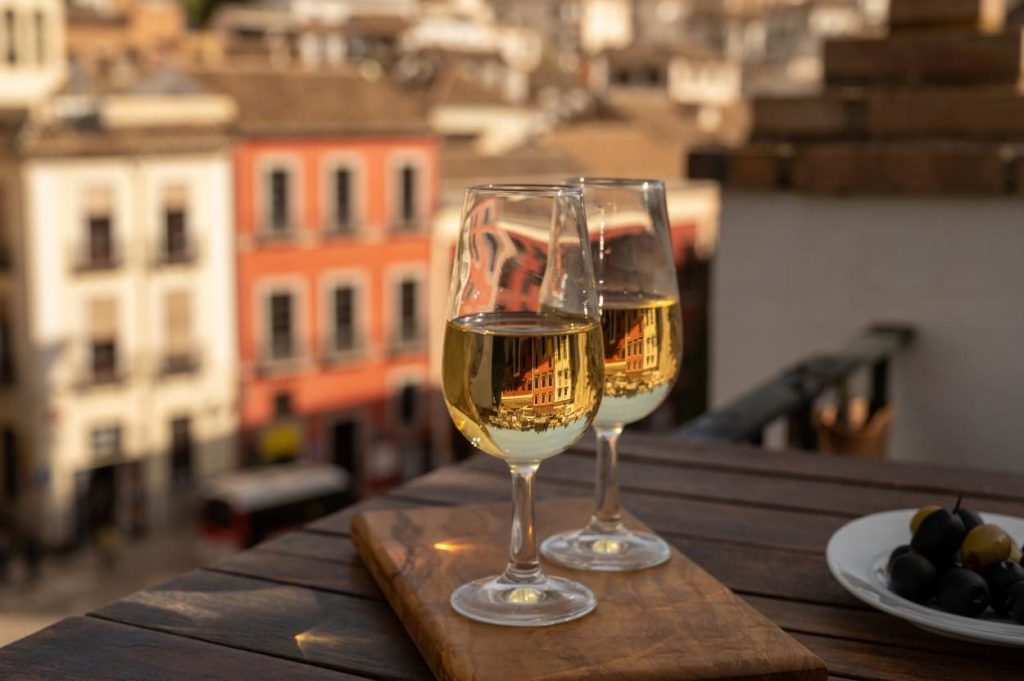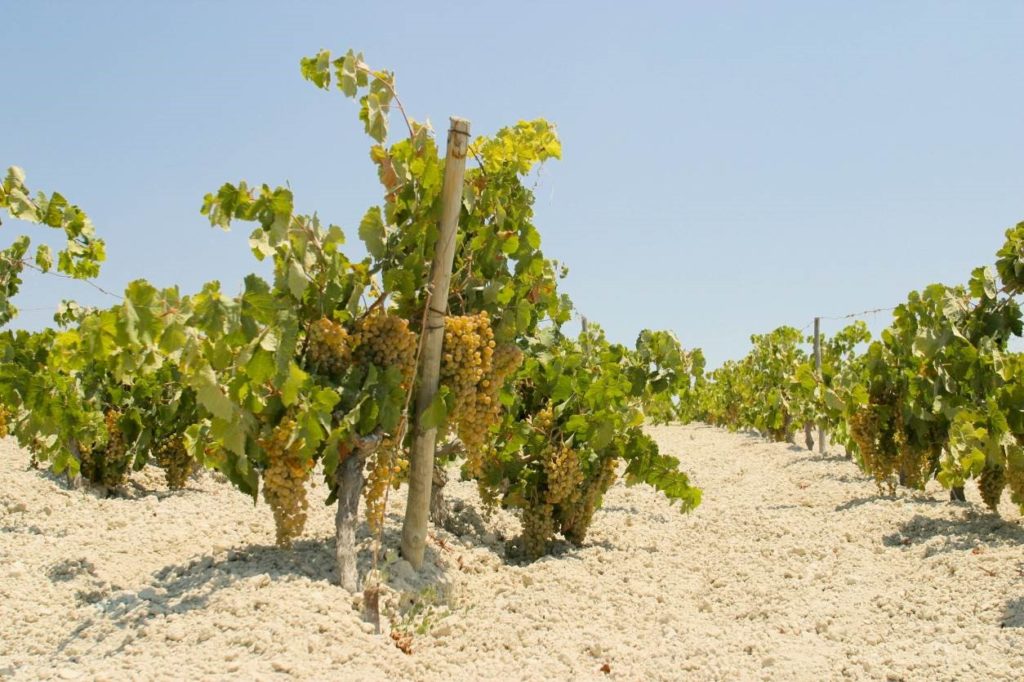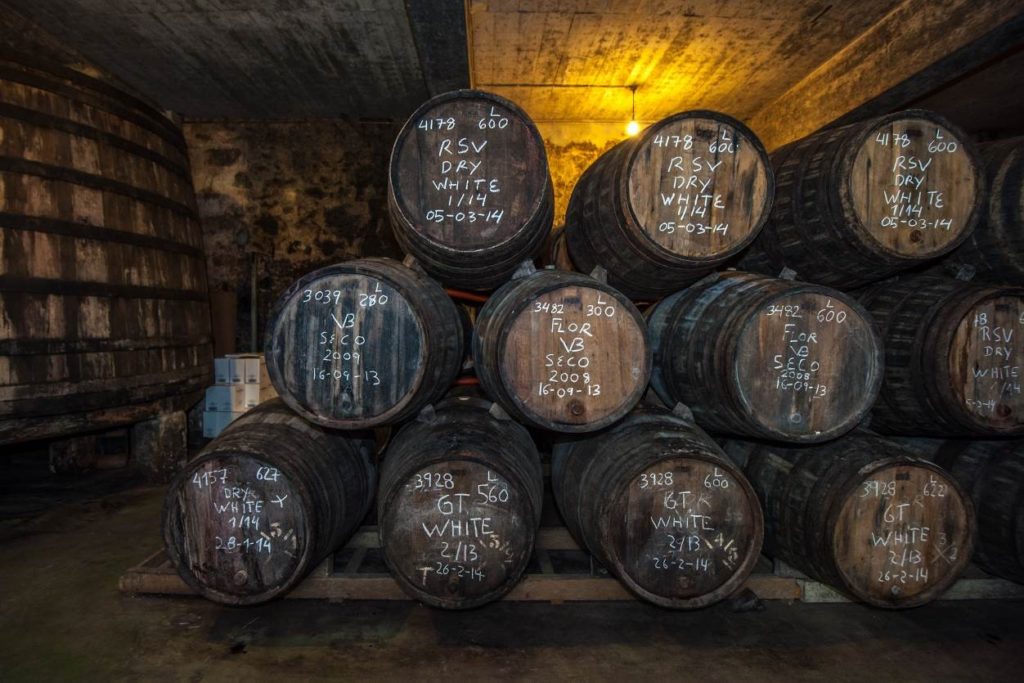
A complete guide to Spanish Sherry wine

Sherry is one of the world’s greatest fortified wines, exclusively produced in the Sherry triangle. The Sherry triangle is centred upon the beautiful town of Jerez de la Frontera in Andalucía, southern Spain. This type of fortified wine is made by adding grape spirit to wine after fermentation, increasing the alcoholic strength of the wine; commonly referred to as fortification. Fortified wine can take several forms: Port wine lodges add the spirit during fermentation, while a few French sweet wines are fortified before fermentation begins.
This habit spread throughout Europe in the 18th Century after Dutch merchants commercialised wine distillation. Initially, fortification was used to sterilise and stabilise barrels of wine before they were shipped abroad. Wine travelled very poorly in the 17th century, however, a small dose of spirit would not only strengthen the wine, but protect it from bacteria. Over time, fortification became a vital part of the wine culture in several regions, including Jerez, Oporto, and Madeira.
The sweetest of the three permitted grape varieties in Sherry, may have cemented the typical image of relatives sipping pale cream sherry at Christmas. However, the vast majority of premium Sherries are bone dry, with a huge variety of Sherry styles produced and drank in Andalucía. Here, we discuss the Sherry appellation boundaries and its permitted grape varieties. We then explore Sherry production and how each style is made.
Click on a link to jump to that section:
Where is Sherry produced?
North of Cadiz, the towns of Jerez de la Frontera, Sanlucar de Barrameda, and El Puerto de Santa Maria constitute the Sherry Triangle, famous for its white-washed houses, patios, flamenco, and nightlife. For more than 2000 years, this has been the heart of Andalucia’s wine industry. Vineyards carpet the hills between Cadiz and Seville, planted on calcareous chalk. The Sherry grape, Palomino, only yields suitable white wine on the water-retentive limey clay known as Albariza. Meanwhile, the climate is quintessentially Mediterranean: hot and dry summers with scant rainfall between May and September. This climate allows intense ripeness to develop in the sweeter Sherry grapes, Moscatel and Pedro Ximènez However, the magic occurs inside the ancient cellars of the region’s numerous bodegas.
In Jerez de la Frontera, historic wineries are dotted across the town. The city of Jerez attracts thousands of visitors yearly in search of excellent gastronomy and fine wine. In fact, the British have long been Sherry’s most important customers; British investors were primarily responsible for the development of Jerez’s export industry in the 19th century. It remains the key driver of regional prosperity, even today.
The white grapes used in Sherry wine
Palomino
The Palomino grape produces very ordinary table wine with low acidity. Yet the Sherry process can transform it into a thing of beauty in Palomino Fino. It tends to be picked when very ripe, as high alcohol is essential in the production of Sherry.
Moscatel (Muscat)
Generally cultivated on sandy soils close to the Atlantic, Moscatel makes very fine sweet Sherry. Grapes intended for sweetening or colouring wine are left to desiccate in the sun before being pressed.

Pedro Ximénez
Indigenous to the Sherry Triangle, Pedro Ximénez is used to make the world’s sweetest fortified wines. Unfortunately, it is relatively difficult to grow, being susceptible to fungal diseases and bunch rot. Nevertheless, its berries will yield high-quality must in good vintages, rich in sugars and acidity.
How Sherry is made
Pressing
Sherry offers various styles, ranging from Fino to Oloroso, that share a common point of origin. Grapes intended for Sherry production are pressed, and the must is typically left to settle for about 24 hours to allow the solid matter to sink to the bottom of the vat. Historically, berries were pressed manually (by foot). However, this has now largely been abandoned in favour of mechanical presses.
Fermentation
Traditionally, vinification was carried out in oak barrels or large concrete vats. However, most bodegas now favour the benefits of stainless steel for its ability to precisely control the fermentation temperature, among other things. Ideally, the fermentation temperature should be kept below 25°C for Fino styles and below 30°C for Olorosos. At the end of fermentation, suspended matter falls to the bottom of the vessel.
Classification
After fermentation, the wines will be classified into three broad categories: Fino, Oloroso, and Rayas (inferior lots). Lighter wines will be used to make Fino Sherry, possibly developing into an Amontillado at a later stage. Heavier wines, meanwhile, will be turned into Olosoros. After the initial classification, Fino wines will be fortified by adding wine spirit to the base wine, bringing up the abv to 15.5%, Olorosos are fortified to 18%.
Maturation
Maturation in old oak barrels is the single most crucial stage in the production of Sherry. Wines are matured in a unique solera system. The term ‘solera’ refers to a vertical stack of oak barrels; solera blending ensures consistency of style and quality by blending young wines with older wines over the years. The barrels containing the oldest wines will always be at floor level – directly above is a container of younger wines, and so on. As older wines are taken from the floor-level barrel to be blended and bottled, they will be replenished with wines from the container sitting directly on top. This process is repeated until we reach the youngest containers of wine. The result is that younger wines can refresh each barrel on the way down. No more than a quarter of the wine will be drawn off at a time.

In the case of Finos, a layer of white yeast called flor protects the wine from oxidation and the attack of acetic acid. It is also responsible for the ‘rancio’ yeasty and nutty character that defines all good Fino Sherries. However, Oloroso sherry does not develop any flor yeast – stronger fortification kills off the yeast before it has a chance to grow. They are designed to offer a richer, more oxidative expression of Sherry.
Bottling
Wines drawn from the solera are often subject to further blending and ageing. They are then clarified and possibly filtered before bottling.
What are the different Sherry styles?
Fino
A crisp and light style of Sherry that is fundamentally shaped by the wine’s interaction with the flor. The bone-dry sherry should be served chilled on a summer’s day alongside a selection of tapas Andalusia’s alternative to Sauvignon Blanc; Fino sherry offers exceptional value for money.
Manzanilla
Manzanilla Pasada is the salt-licked cousin of Fino Sherry, made exclusively in the cellars of Sanlúcar de Barrameda. The humid climate of the town encourages the development of a very thick layer of flor – Manzanillas are renowned for their racy acidity and nutty flavour.
Amontillado
From one perspective, Amontillados are made by accident. It is a style of Sherry that begins life as a Fino. However, it is allowed to age after the protective layer of flor has died out. The extra period of maturation in barrel, combined with the higher alcohol content (evaporation from the porous wood concentrates the alcohol), imbues Amontillado sherry with a richer and rounder palate. It is the perfect winter aperitif.
Oloroso
Oloroso Sherries are not aged under a protective layer of flor because they are fortified to the extent that the yeast is killed off. Instead, the style is allowed to gently oxidise, creating a complex and opulent fortified wine. These are wonderfully intense and concentrated Sherries.
Palo Cortado
A rare type of Sherry, Palo Cortado starts its journey as a Fino/Amontillado. Yet, in some instances, the flor dies out unexpectedly or is killed off earlier in the maturation process, exposing the wine to controlled amounts of oxidation. Thus, the freshness of Fino and the complexity of dry Amontillado are combined. These Sherries have penetrating aromas of pine nuts and caramel.
Cream Sherry
All Sherries are fermented dry. Sweet wine styles are made by adding sugar-rich wine before bottling. In the case of cream Sherries, this will usually be a dose of fortified Pedro Ximènez, unctuous with an essence of dried fruit.
Pedro Ximenez
Made from the desiccated berries of the noble Pedro Ximenez variety, these Sherries are rich, buttery and packed full of sugar. They can stand up to any dessert.
Enjoying Sherry today
Over the past decade, the industry has made a concerted effort to appeal to a broader consumer base, promoting new label designs and reinforcing the incredible diversity of the Sherry category. As a result, this historic tipple is becoming trendy again; Sherry has historically been viewed as an oversweet dessert wine. However, the majority of authentic Sherry is bone dry and Manzanilla Sherry is intensely saline. Yet the richness and weight of the wine balance the lack of sweetness. When served with a selection of mouthwatering tapas, Sherry becomes the ultimate food pairing.
Try one of our Sherry wines today!
What to read next
A guide to Spanish wine regions: Rioja
A guide to Spanish wine regions: Rias Baixas




